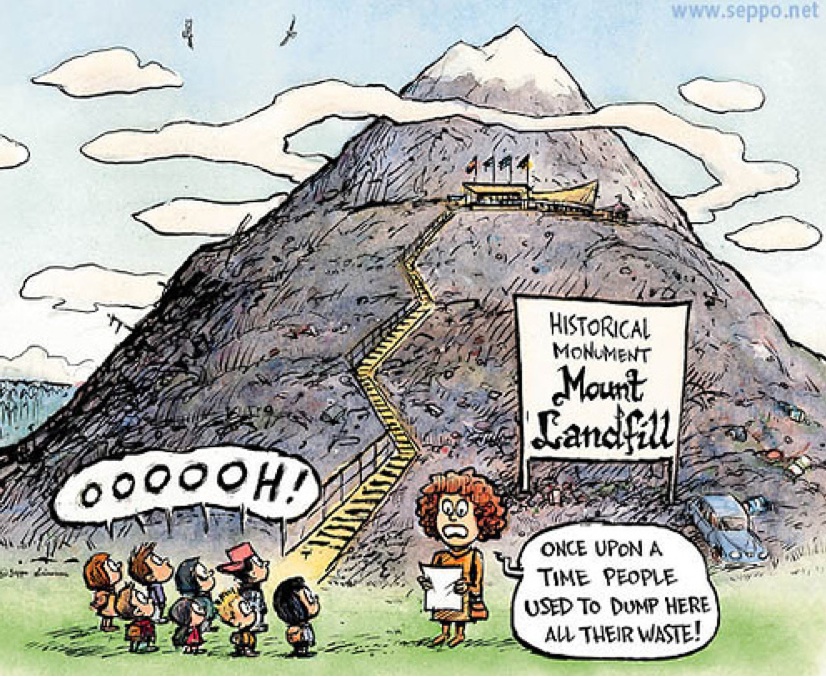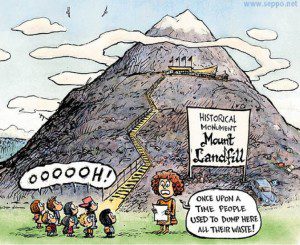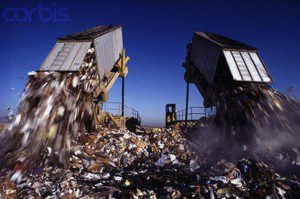
22 Jun EARTH MATTERS: WASTE NOT, WANT NOT
Glued to the screen  spellbound, I watched a person portraying a traditional Native American sitting on horseback staring at something so horrific that tears were painfully running down his stoic, weathered face. Silently, as the camera slowly panned back, the image on the screen revealed the cause of his anguish. In the background, a bulldozer was dumping trash over the edge of a vast pit comprised of layers upon layers of previously discarded waste that had transformed the natural landscape. Environmental outreach programs in the early 1970s, supported by the newly established Federal Environmental Protection Agency in 1972, generated a fresh wave of environmental awareness that swept over mainstream America. Via mass media, the environmental movement of the 1970s planted seeds that propagated a surge of “smart growth” community planning and environmental advocacy groups in the last few decades.
spellbound, I watched a person portraying a traditional Native American sitting on horseback staring at something so horrific that tears were painfully running down his stoic, weathered face. Silently, as the camera slowly panned back, the image on the screen revealed the cause of his anguish. In the background, a bulldozer was dumping trash over the edge of a vast pit comprised of layers upon layers of previously discarded waste that had transformed the natural landscape. Environmental outreach programs in the early 1970s, supported by the newly established Federal Environmental Protection Agency in 1972, generated a fresh wave of environmental awareness that swept over mainstream America. Via mass media, the environmental movement of the 1970s planted seeds that propagated a surge of “smart growth” community planning and environmental advocacy groups in the last few decades.
From before the days of the “Give a hoot and don’t pollute” pick-up trash campaign in the 1970s, municipal solid waste management has been one of the sectors of society (along with energy infrastructure efficacy, transportation, water conservation, alternative energy, and land use) that has attracted attention because of its interrelationship to all facets of human activity and the environment. In 1996, the city of San Francisco developed a curbside composting program that successfully reduced landfill waste and produced commercial grade soil for agriculture. Furthermore, peer-reviewed scientific research indicates that municipal solid waste landfills are a significant contributor to human-induced greenhouse gas emissions and consequent global warming. Thus, it is imperative that comprehensive community planning incorporate sustainable methods of solid waste management designed to reduce environmental impact, create economic opportunities along with encouraging a proactive shift in social behavior towards a sustainable lifestyle.
Municipal Solid Waste Management
Current municipal solid waste (MSW) practices contribute to a wide range of environmental impacts depending on a locality’s choice of MSW management options. In the European Union (EU), about 60% of MSW is disposed into landfills. As a consequence, approximately 30% of the greenhouse gas emissions produced by the decay of biodegradable waste in airless (anaerobic) conditions in the landfills are methane (CH4). In contrast, EU landfills produce only about 1% nitrous oxide (N20) and less than 0.5% carbon dioxide (CO2) greenhouse gas emissions. In an effort to reduce CH4 greenhouse gas emissions from landfills, European Commission (EC) developed the following guideline of general principles for the treatment of biodegradable wastes:
–Prevent or reduce bio-waste production and its contamination by pollutants
–Re-use bio-wastes (e.g. cardboard)
–Recycle separately-collected bio-waste into original material (e.g. paper and cardboard) whenever environmentally justified
–Composting or anaerobic digestion of separately-collected bio-waste that is not recycled into original materials, with the compost so produced being used in agriculture or for other environmentally beneficial purpose
–Mechanical and biological treatment (MBT) of non-source separated bio-waste as a pre-treatment for landfill disposal
–Use of bio-waste for energy recovery
The multitude of technologies and methods used to satisfy the EC guidelines for sustainable MSW management include reserving landfills for stabilized waste, capturing landfill gas for fuel, mechanical-biological treatment prior to landfilling, composting, anaerobic digestion in sealed containers, recycling, and incineration.
According to the Environmental Protection Agency, the average American in 1960 generated only 2.68 pounds per day of solid waste. In 2008, the average American generated 4.5 pounds per day of solid waste. Fortunately, the implementation of “recycle and reuse” programs by government agencies, advocacy groups, and others has resulted in 24.3% of our solid waste being recycled and 8.9% being composted. Although the current MSW policies and programs are a step in the right direction, 66.8% of our solid waste continues to be put into landfills that are prone to leak toxic chemicals into the ground and surface water as the landfill barrier liners begin to fail over time.
Currently, over 7 billion pounds of PVC plastic, commonly used in construction, are discarded into landfills each year. Sadly, only about one quarter of 1% of the PVC waste is reused, recycled, or converted into energy. Compounding the problem, the production of chlorine for making PVC products uses almost as much energy as the annual output of eight medium-sized nuclear power plants each year. A potential solution entails developing a PVC substitute that did not require intensive energy to be produced and could be easily recycled or reused. Another option would be to use the PVC to generate energy. However, recycling or reusing saves three to fives times the energy generated by waste-to-energy plants. Waste incineration plants are also a major source of approximately 210 different dioxin compounds, plus mercury, cadmium, nitrous oxide, hydrogen chloride, sulfuric acid, fluorides, and particulate matter.
Over the long run, in comparison to recycling, reusing, or converting waste to energy, the most effective and sustainable MSW management option involves facilitating a shift in public and private sector behavior towards waste prevention. By fostering a behavioral shift away from consumerism and developing closed waste management systems, humanity can significantly reduce environmental impacts caused by the production and disposal of materials that currently contribute significantly to environmental degradation and global warming.



Sorry, the comment form is closed at this time.